We forgot to take our hats to Chelsea this year, rushing out of the door to catch the train, calling out to our son to remember to walk the dog (as if she’d let him forget). A love of plants and gardening is something David and I share, so we try to visit the Chelsea Flower Show every year if we can. It means a day out together; sunshine (I can only remember one really wet year); inspiring displays of plants and colour; friendly crowds (there are always a few shovers but everybody seems happy, even the exhausted people on the gardens and trade stands); camera crews and celebrity-spotting; gawping at stands selling crazily expensive sculptures and garden furniture and every conceivable garden accessory; ice cream and Pimms; finding a spot in the usually rammed picnic glade to eat lunch; coughing as though you’re a 40-a-day smoker after inhaling some of the London plane tree fibres that fall like confetti over the showground at this time of year; people-watching (from fabulous dresses and smart suits to jeans and t-shirts, and people who are definitely dressing to be caught on camera); 10 Whistlefish greetings cards for £8 (great for stocking up); sponsorship bags bulging with leaflets and plant lists; sampling tiny porcelain bowls of interesting teas at the Wedgewood tea bar (David was rather mortified to be remembered from last year); listening to music of variable quality sitting next to the bandstand while taking a break; meeting old friends and new (we met up with the lovely Jenny of Duver Diary and her husband); going back to see the gardens in different light as the day wears on; trying to see everything – trying to not miss one single bit of it.
There’s been a whole heap of coverage of the show on social media and in the press but I hope you can bear a little more! You won’t find detailed background info or in-depth analysis here (if you want that, I highly recommend Dan’s blog), but I wanted to share some snapshots that caught my eye and a few observations from our visit on Tuesday. There are quite a few photos… (I’d put the kettle on.)
If you go to Chelsea as an ordinary visitor (as in, you’re not lucky enough to be there on Press Day or behind the scenes), you are unlikely to be able to absorb all the detail of the show gardens or to even see much of the incredibly intricate landscaping, fittings and finishes. There is so much that goes unseen by ‘the public’ because we have to stand at the edges of gardens along one of two sides (show gardens are generally on a corner plot) and not walk in them. As a visitor, it can be frustrating but I suppose you couldn’t have hordes of people traipsing through immaculate gardens. Unless there’s an unseemly scrum, you can usually find a spot to squat down and look more closely at the plants and try to get a peek at what’s going on in and behind the magnificent garden structures but much of the detail is for the scrutiny of the RHS judges alone. After all, the main point of Chelsea, for those who sponsor, design and build these gardens, is winning a coveted RHS medal. Gold medals, in particular, equal publicity. Publicity equals higher profile and more business, etc, etc.
Nevertheless, there is still an awful lot of pleasure to be gained from visiting as a punter and soaking up the horticultural atmosphere and seeing the gardens first-hand. The tv coverage might show you parts of the gardens you can’t get to but nothing quite beats seeing them in real life and you might even be able to chat to a designer or two. It’s wonderful to be able to gaze at the planting close up, to find new and interesting plant cultivars and meet the growers and experts in the Grand Pavilion. David and I discussed the garden merits of eucalyptus, whether we could ever get a clematis to grow in our garden and the bizarre world of bonsai with nursery-owners or growers who were hugely generous with their knowledge. We also asked the advice of the lovely chaps at Pennard Plants on the best wild flowers for bees (Phacelia tanacetifolia is a corker, apparently) and bought some of their wonderful heritage seeds.
Anyway, without further ado, here’s what captured my attention:
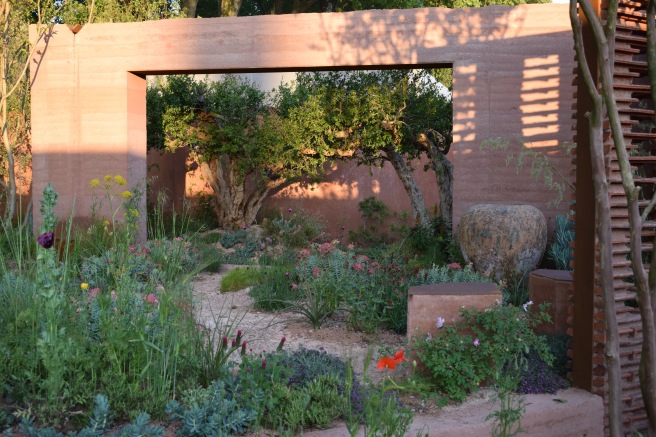


Three pics above: I loved the overall effect of the M&G garden designed by Sarah Price – the naturalistic planting with gorgeous contrasts of soft and spiky textures, warm earthy colours, dripping water features and the terracotta structures (made with reclaimed French roof tiles and earth rammed in to shuttering).
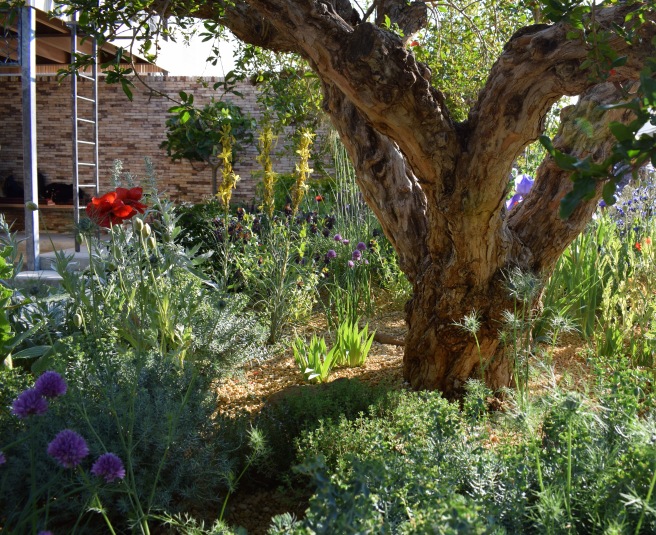
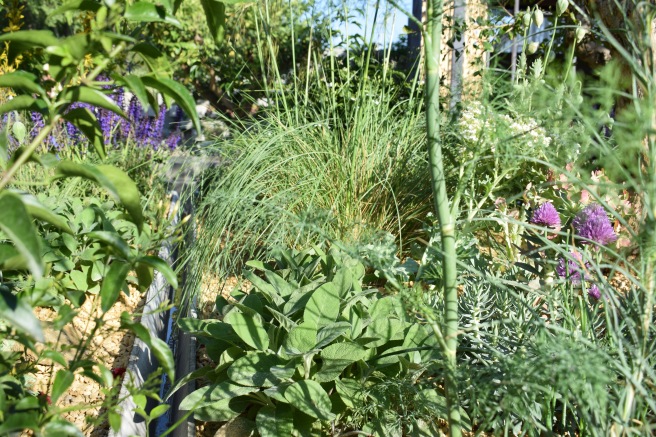
Two pics above and two below: another favourite was The Lemon Tree Trust garden designed by Tom Massey and inspired by his visit to a refugee camp in Iraq. Rills radiate from a central water feature and the planting includes beautiful pomegranate trees and heart-stopping combinations of alliums, euphorbias (including the lovely E.pithyusa below), salvias, poppies, roses, irises and a lemon tree. I loved the planting in a wall of concrete blocks.


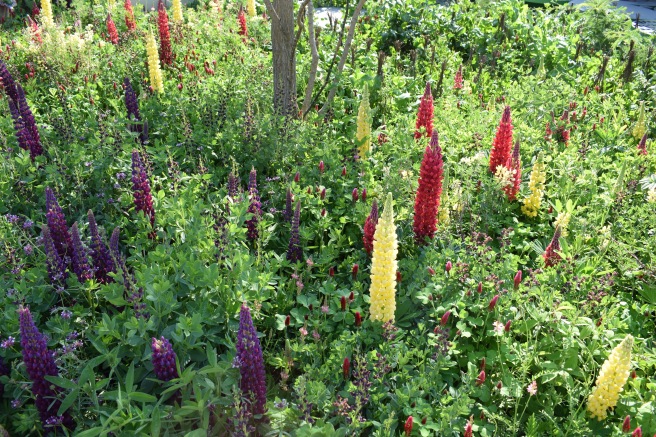

Two pics above: Lupins featured large throughout the show but I think they were used most brilliantly here in the Seedlip Garden, which was full of pea-related plants, designed by Dr Catherine MacDonald. The lushness and colours are swoon-y.
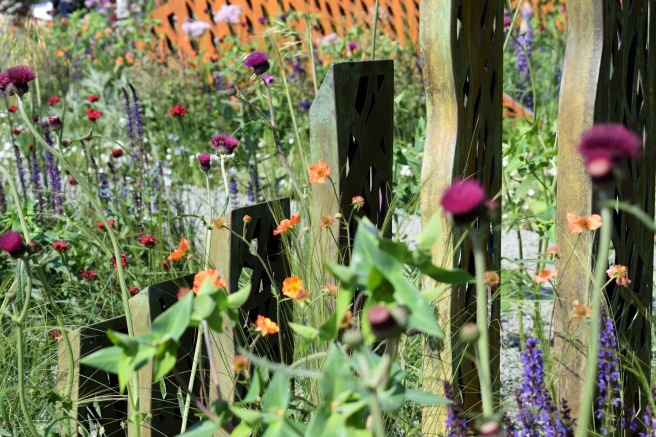
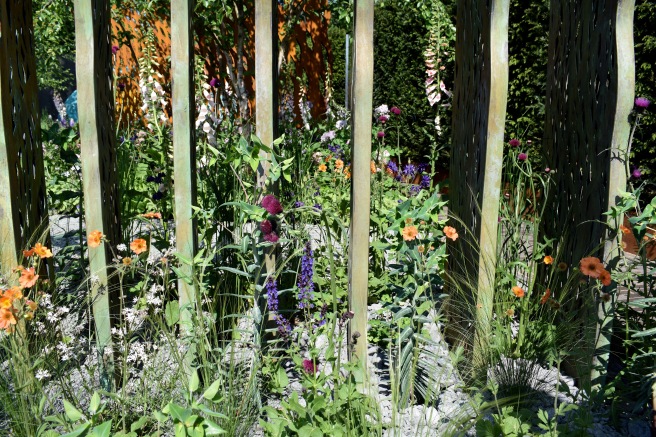

Three pics above: I’m really into layering with plants – repeat planting, using ‘see-through’ plants, building up layers of colour and texture – and this garden boldly emphasised its layers with the use of sculpture. The message behind The David Harber and Savills garden (mankind’s evolving relationship with the environment) may have mostly been told through the bold sculpture but it was the planting that appealed to me.

Above and below: a new-to-me shrub – Enkiathus – was used to great effect in the Morgan Stanley Garden for the NSPCC, designed by Chris Beardshaw (above), and in the O-mo-te-na-shi no NIWA – The Hospitality Garden, designed by Kazuyuki Ishihara (below), which also featured his trademark moss. I do love a raised canopy that shows the detailed structure of a shrub or tree.
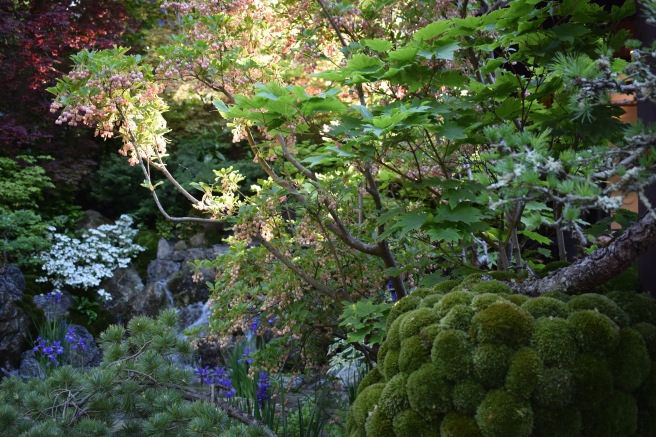
Below: I loved the blue and copper colour scheme of The Silent Pool Gin Garden designed by David Neale. Again, there’s that bare-multi-stem-raised canopy thing going on.
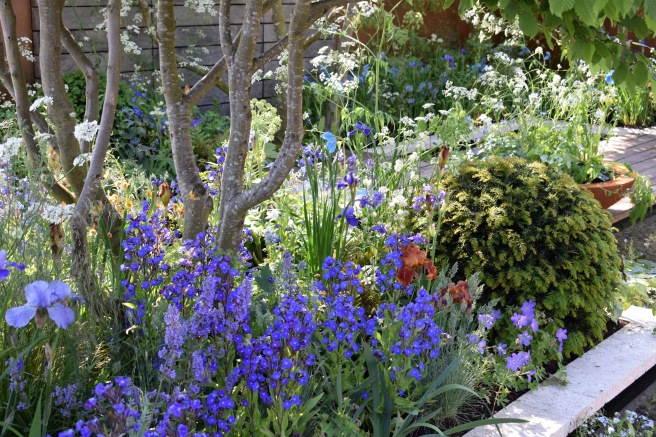
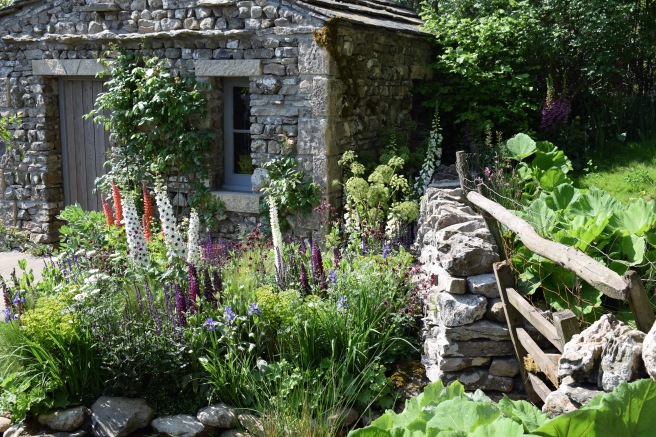
Above: The Welcome to Yorkshire garden was creating quite a buzz – it is a beautiful snapshot of the Dales, dry-stone wall, stone bothy with a beck running past, cottage planting and all, but… There’s no denying the skill and attention to detail but I think the countryside picked up and plonked at Chelsea has been done to death now.
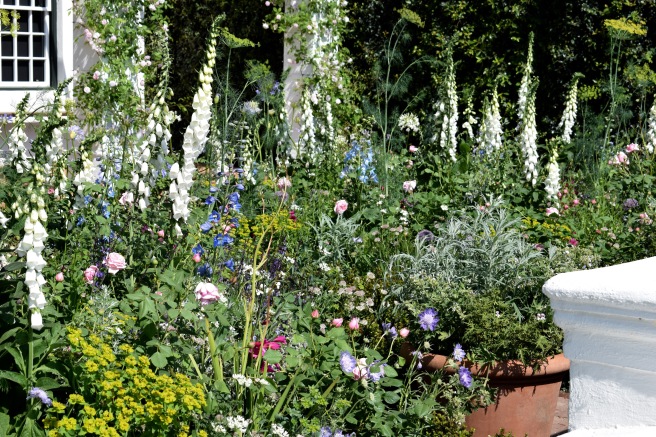
Above: this fantastic cornucopia of flowers was outside a recreated Cape Dutch homestead on the Trailfinders South African Wine Estate garden. It’s slightly bonkers but I loved it.
Above: hanging plant pots on the Burgon & Ball stand, garden sculpture and a detail from the pietra dura marble used on the British Council’s artisan garden (India: a billion dreams, designed by Sarah Eberle).
Below: plants in the Grand Pavilion that are now on my wish list – Digitalis x valinii ‘Illumination Cherry Brandy’, Geum ‘Scarlet Tempest’ and Lysimachia atropurpurea ‘Beaujolais’.
Below: detail from one of the many amazing floral arrangement displays inside the Pavilion.
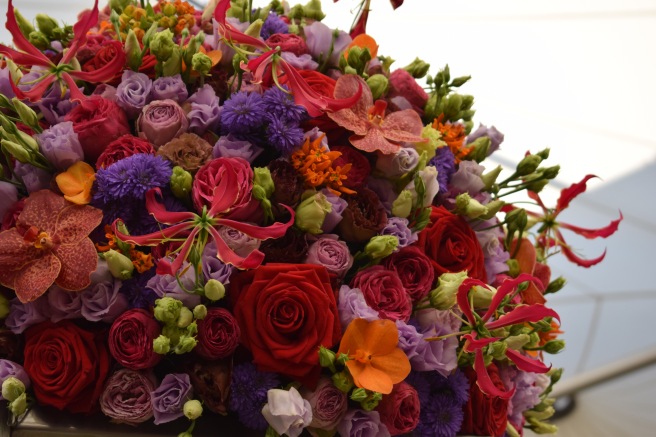
Below: gardens at Chelsea aren’t all about big business. This garden, called Laced With Hope, promoted the work of the charity Supershoes. It illustrates the typical journey of a child with a cancer diagnosis and the work the charity does to empower these children. The plan is for the garden to be moved to a children’s cancer hospital after the show so it can be used and enjoyed by patients and their families for years to come.


Above: more top dry-stone walling on the artisan garden, A Very English Garden, designed by Janine Crimmins. I also loved the effect of the Erigeron around the central planter.
Below: I’ll leave you with another photo of a stand in the Grand Pavilion (I can’t remember which one it was, sorry) because it shows the stars of the show – the plants. Did you go to the show this year? If so, what were your highlights?









You really did see everything! I haven’t been for years, it’s just too far away now sadly. I have to content myself with Monty and Joe. But you’re right, nothing beats the atmosphere. I’m glad you had a good day.
LikeLiked by 1 person
I love seeing your personal take on Chelsea. And that you have featured Lupin ‘Masterpiece’. That digitalis too is just divine.
LikeLiked by 1 person
This is a great overview of the garden show that I’ve heard so much about and will probably never attend. It’s a little far to go. The wild looking South African garden caught my eye with the tall white foxgloves. Is it just me, or do foxgloves seem to be regaining popularity? They are flourishing in my garden, uninvited, but quite welcome.
LikeLiked by 1 person
Foxgloves are always welcome here, too. I think they are quite popular at the moment.
LikeLike
Wow, that dry stone walling is phenomenal. Glad you had a good day there and that the sun shone. And that David is now a regular at the fancy tea bar, recognition is a good thing. CJ xx
LikeLiked by 1 person
Looks as though you had a great day. The lupins look fabulous don’t they? I wish mine looked like that instead of always covered in aphids. As I’m in the process of creating a new garden, I really should go along to Chelsea but am put off by the crowds. Maybe next year I shall make the effort.
LikeLiked by 1 person
It’s an experience, Anne. Definitely worth going at least once and you’ll come away with loads of ideas.
LikeLike
Beautiful pictures, plants and dry stone walling, a real feast for the eyes lucky girl Joy x
Sent from my iPad
>
LikeLiked by 1 person
I am awed by that stonework!
LikeLiked by 1 person
I didn’t go this year but I really enjoyed your perspective of it. A great post Sam. Thank you.
LikeLiked by 1 person
As others have said, when we have only seen it all from the BBC team’s persoective it is always refreshing to hear about it from one of our own community. I look forward to seeing a vase like the one you showed for next week’s IAVOM!
LikeLiked by 1 person
Haha. In my dreams 🙂
LikeLike
Gorgeous photos and a really enjoyable walk through Chelsea. We don’t get to see any of it here in Germany, so your post was a lovely insight while drinking my morning coffee. I think I might make myself another cup and go back and look again! Thanks Sam!
LikeLiked by 1 person
Glad you enjoyed it.
LikeLike
So much delicious color! I love the lupines and the orange geums.
LikeLiked by 1 person
Thank you from Australia! x
LikeLiked by 1 person
You’re welcome!
LikeLiked by 1 person